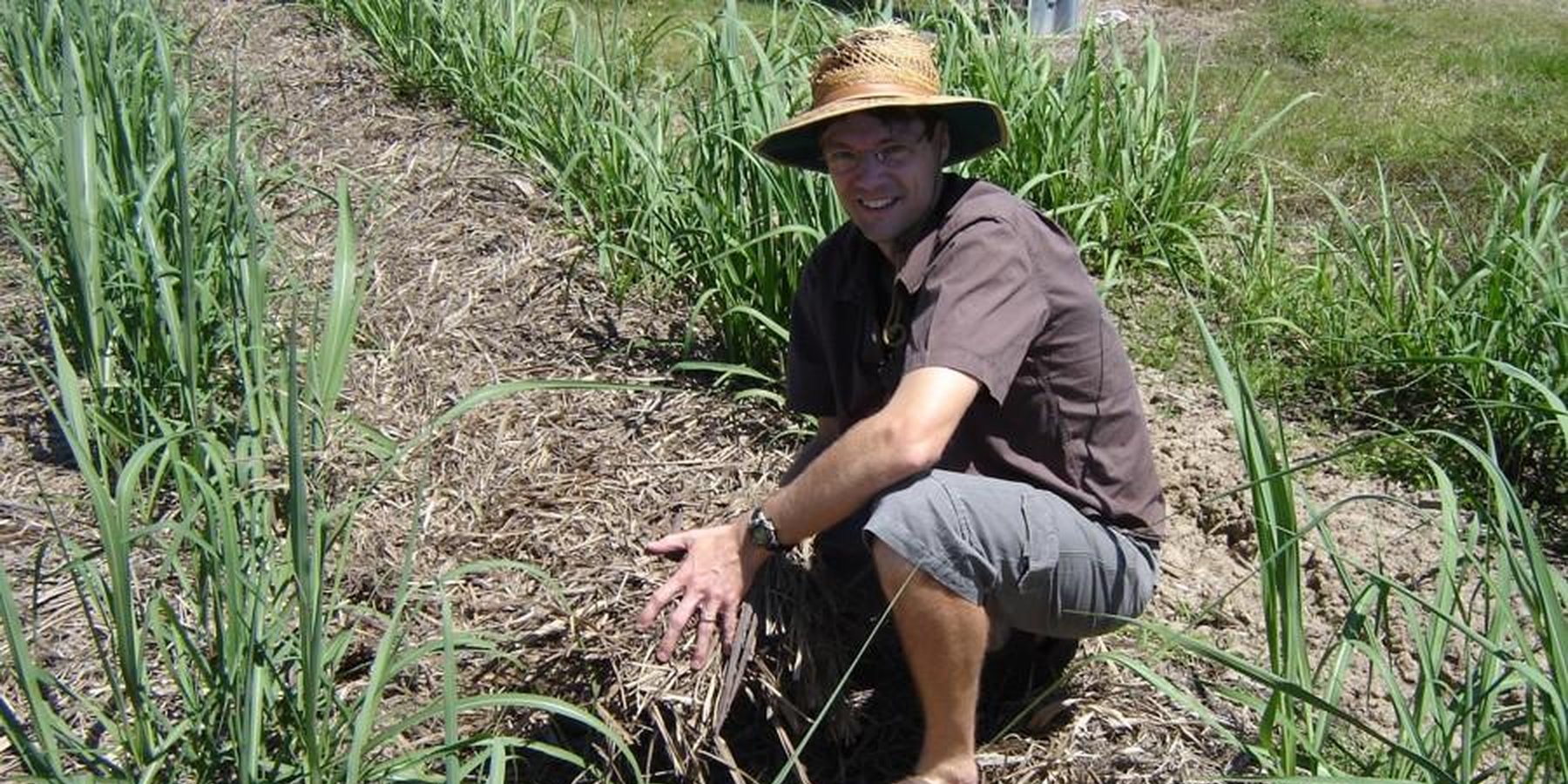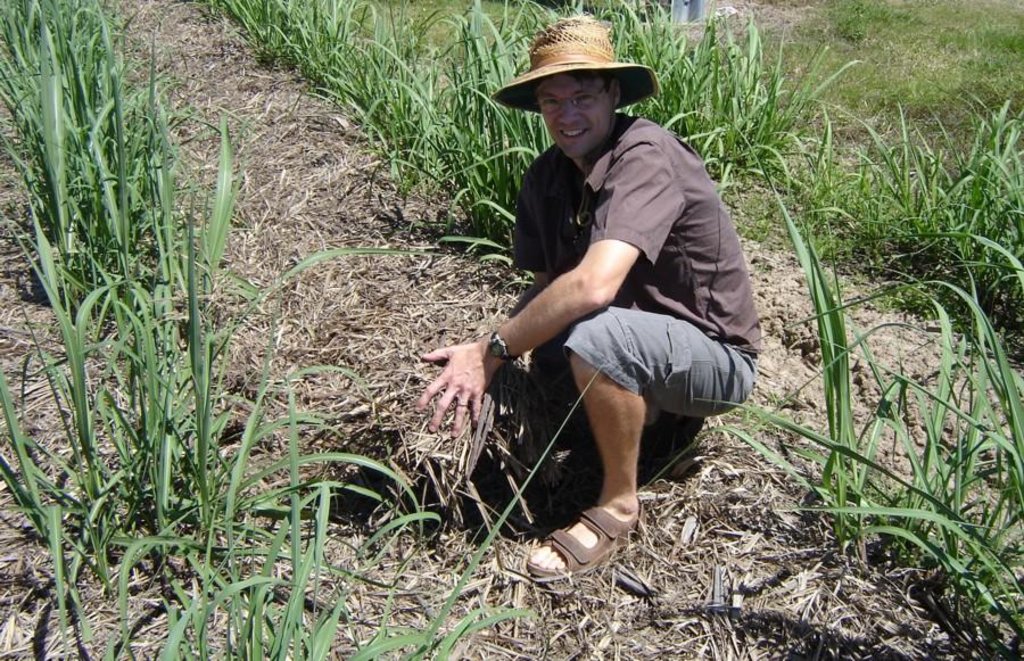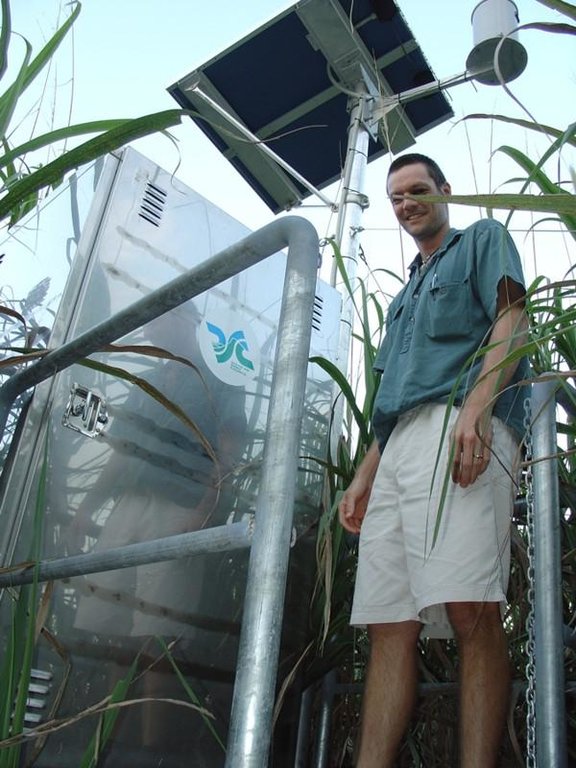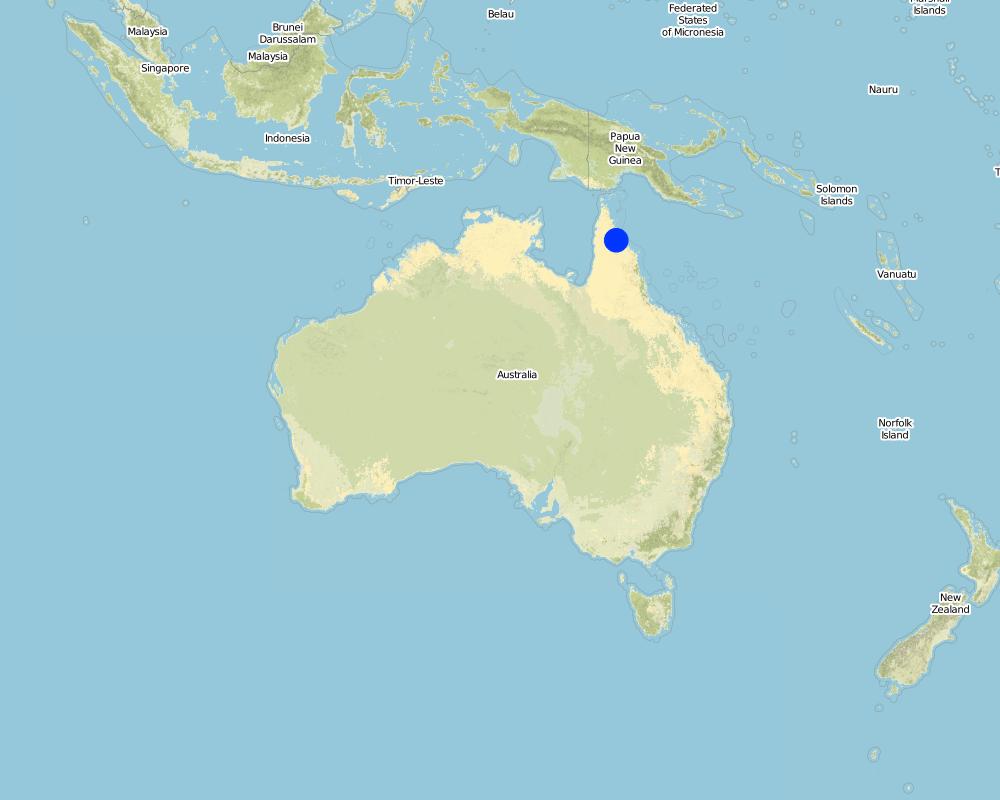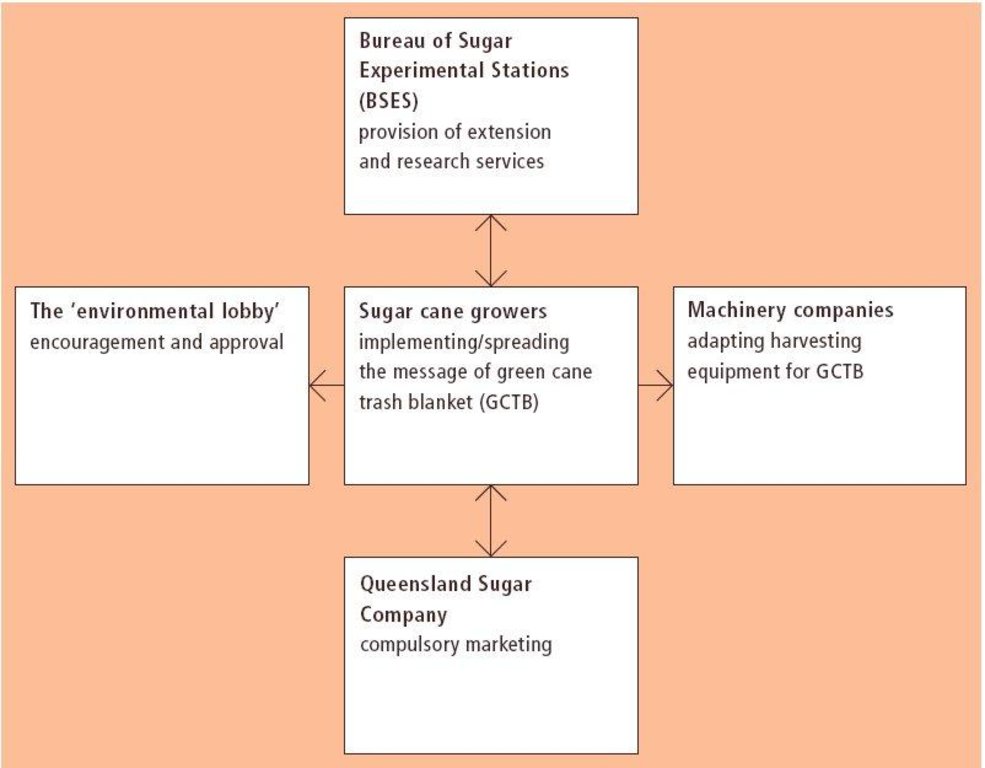The 'Triple bottom line' [Австрали]
- Шинийг нээх:
- Шинэчлэх:
- Эмхэтгэгч: Anthony J. Webster
- Хянан тохиолдуулагч: –
- Хянагчид: David Streiff, Deborah Niggli
approaches_2668 - Австрали
Бүлгүүдийг үзэх
Бүгдийг дэлгэх Бүгдийг хаах1. Ерөнхий мэдээлэл
1.2 Арга барилыг баримтжуулах болон үнэлгээ хийхэд оролцсон хүн эсвэл байгууллагын холбоо барих хаяг
Арга барилыг баримтжуулах/үнэлэх ажилд дэмжлэг үзүүлсэн төслийн нэр (шаардлагатай бол)
Book project: where the land is greener - Case Studies and Analysis of Soil and Water Conservation Initiatives Worldwide (where the land is greener)Арга барилыг баримтжуулах/үнэлэх ажилд дэмжлэг үзүүлсэн байгууллага(ууд)-ын нэр (шаардлагатай бол)
CSIRO (CSIRO) - Австрали1.3 WOCAT-аар баримтжуулсан өгөгдлийг ашиглахтай холбоотой нөхцөл
Эмхэтгэгч болон гол мэдээлэгч хүн(хүмүүс) WOCAT аргачлалаар баримтжуулсан мэдээллийг ашиглахтай холбоотой нөхцлийг хүлээн зөвшөөрсөн:
Тийм
1.4 ГТМ-ийн технологийн асуулгын(д) суурь мэдээлэл(д)
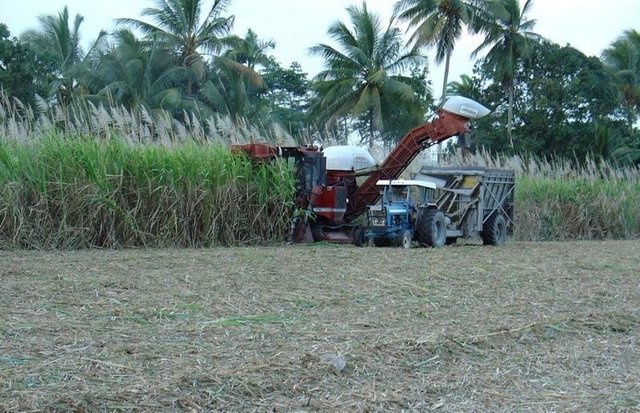
Green cane trash blanket [Австрали]
Elimination of burning as a pre-harvest treatment of sugar cane, and managing the resultant trash as a protective blanket to give multiple on and off-site benefits.
- Эмхэтгэгч: Anthony J. Webster
2. ГТМ Арга барилын тодорхойлолт
2.1 Арга барилын товч тодорхойлолт
A new expression used by agriculturalists in Australia to explain why farmers change practices: the 'triple bottom line' implies economic, environmental and social concerns.
2.2 Арга барилын дэлгэрэнгүй тодорхойлолт
Арга барилын дэлгэрэнгүй тодорхойлолт:
Aims / objectives: A fundamental change has occurred in farming practice amongst sugar cane growers in the tropics of far north Queensland. Where it was once standard practice to burn cane before harvest (defoliating green canes for easier harvest), tradition has been turned on its head and now almost no-one burns. Instead a 'green cane trash blanket' system has developed, with multiple benefits and few or no drawbacks. There has been no official campaign or punitive sanctions imposed, no enticing financial incentives offered or charismatic environmental leadership - just a quiet technological revolution, based on the principles of the 'triple bottom line' (TBL).
Methods: TBL has recently emerged into common usage amongst agriculturalists in Australia. Rather than attributing farmers' actions as simple responses to economic stimuli ('the bottom line') TBL is a framework that helps explain the complexity of factors that influence farmers to modify their practices. TBL suggests that farmers do indeed respond to money, but also to environmental concerns, and furthermore to social considerations as well. This gives credit to farmers for being responsible stewards of the land. In this particular case, the transition in technology started in 1974, when sugar cane growers in the far north of Queensland were simply unable to burn their cane prior to harvest because of the exceptionally heavy rains. Instead, they had to harvest wet - and green. The technical implications were first, a slower harvest speed because machinery had to cope with a greater load of biomass, and second, a thick residual blanket of trash that covered the soil. The multiple benefits of mulching were recognised by a few growers, who then continued to harvest green cane. Non-burning spread - a technology now described as the 'green cane trash blanket'- until almost every grower adopted it within one generation. While the extension service has supported the transition, growers themselves tookthe initiative to change. There are indeed small financial benefits, chiefly in terms of reduced overall input costs, but growers have simultaneously been motivated by social and environmental considerations. Burning has come to be considered anti-social: a dirty practice, carrying the danger of fire spreading outside the targeted fields. Neither is it a pleasant task, requiring help of family and friends, often at inconvenient times.
Other important information: From an environmental perspective, the benefits of trash mulch are tangible in terms of improved soil quality, and reduced erosion rates. And, equally important, the end result is reduced damage to the close-by Great Barrier Reef with its sediment-sensitive living coral.
The triple bottom line(TBL) is an expression which has evolved in Australia to help explain why farmers act as they do. Its three components of economics, the environment and social aspects cover the considerations that cause farmers to modify technologies. TBL implicitly gives credit to farmer for being sensitive to multiple external signals. In this case the change in practice is from burning sugar cane to harvesting it green in Far North Queensland. This is a case where emerging conservation-friendly farmer practice and the goals of the environmental lobby have neatly coincided.
2.3 Арга барилын зурагууд
2.5 Арга барил нэвтрүүлсэн улс орон / бүс нутаг / байршил
Улс:
Австрали
Улс/аймаг/сум:
Queensland
Map
×2.6 Арга барилыг эхлэх, дуусах огноо
Эхлэх жилийг тэмдэглэ:
1974
2.7 Арга барилын төрөл
- уламжлалт / уугуул
2.8 Арга барилын үндсэн зорилго, зорилтууд
The Approach focused on SLM only
(1) Demonstration and dissemination. (2) The spread of non-burning practices, specifically the 'green cane trash blanket' technology to promote sustainable and environmentally friendly sugar cane production. (3) Indirectly: to satisfy social concerns associated with burning of sugar cane.
The SLM Approach addressed the following problems: (1) Anti-social farming practice of burning sugar cane which also has negative environmental impacts, both in situ, and offsite in the coral reef. (2) Resistance to change in traditional farming practice.
2.9 Арга барилын хүрээнд хэрэгжсэн Технологи/Технологиудад дэмжсэн эсвэл саад учруулсан нөхцлүүд
нийгэм / соёл / шашны хэм хэмжээ, үнэт зүйлс
- Хазаарлалт
traditional way of doing things/social resistance
Treatment through the SLM Approach: demonstration and dissemination of benefits
санхүүгийн нөөц, үйлчилгээний хүртээмж / боломж
- Хазаарлалт
Higher costs of harvesting (a small premium charged by contractors per tonne of green cane harvested).
Treatment through the SLM Approach: These costs are offset by lower tillage input, no costs associated with burning, and lower inputs of agrochemicals also.
Хууль, эрхзүйн хүрээ (газар эзэмшил, газар, ус ашиглах эрх)
- Идэвхижүүлэх
- Хазаарлалт
ГТМ-ийн талаарх мэдлэг, техникийн дэмжлэг авах боломж
- Хазаарлалт
Harvesting machines at first were not so well able to cope with the greater biomass to be harvested.
Treatment through the SLM Approach: Manufacturers developed higher capacity harvesters.
3. Оролцогч талуудын оролцоо ба үүргүүд
3.1 Арга барилд оролцогч талууд болон тэдгээрийн үүргүүд
- Орон нутгийн газар ашиглагч / орон нутгийн иргэд
There is no difference between men and women in principle, though de facto most growers are male.
- Засгийн газар (шийдвэр гаргагч, төлөвлөгч)
politicians (govt. agencies)
- environmentalists
3.2 Арга барилын янз бүрийн үе шатанд орон нутгийн газар ашиглагчид / бүлэглэлүүдийг татан оролцуулах
| Орон нутгийн газар ашиглагч / орон нутгийн иргэдийн оролцоо | Хэн оролцсоныг тодорхойлж, үйл ажиллагааг тайлбарлана уу | |
|---|---|---|
| санаачлага/идэвхжүүлэлт | өөрийн хүчийг нэгтгэсэн | starting up the practice; starting up the practice of green cane trash blanket (GCTB) |
| Төлөвлөгөө | үгүй | |
| Хэрэгжилт | интерактив | spreading the word; growers spreading the word, support by extension services |
| Мониторинг/ үнэлгээ | интерактив | growers joining hands with research; formal and informal disseminations of observations |
| Research | интерактив | growers joining hands with research. Quantifying benefits short, long term and downstream |
3.3 Диаграм (хэрэв боломжтой бол)
Тодорхойлолт:
Institutional framework Inter-relationships between sugar cane growers and other stakeholders.
3.4 ГТМ-ийн технологи/технологиуд сонгох шийдвэр
Хэрэгжүүлэх Технологи/Технологиудын сонголтыг хийж шийдвэр гаргасан хүнийг тодорхойлно уу:
- Газар ашиглагч дангаараа (өөрийн санаачлага)
Тайлбар:
sugar cane growers
Decisions on the method of implementing the SLM Technology were made by by land users* alone (self-initiative / bottom-up)
4. Техникийн дэмжлэг, чадавхи бүрдүүлэх, мэдлэгийн менежмент
4.1 Чадавхи бэхжүүлэх/сургалт
Газар эзэмшигчид / бусад оролцогч талуудад сургалт явуулсан уу?
Үгүй
4.2 Зөвлөх үйлчилгээ
Газар ашиглагчдад зөвлөх үйлчилгээ авах боломжтой байдаг уу?
Тийм
Зөвлөх үйлчилгээ үзүүлсэн эсэхийг тогтоо:
- Газар ашиглагчийн талбай дээр
Тодорхойлолт / тайлбар:
Name of method used for advisory service: green cane trash blanket (GCTB) system; Key elements: visits, Field days, publications; (1) Advisory service was carried out through: Bureau of Sugar Experimental Stations (BSES).(2) Advisory service was carried out through: Bureau of Sugar Experimental Stations (BSES).
4.3 Институцийг бэхжүүлэх (байгууллагын хөгжил)
Арга барилаар дамжуулан институц байгуулагдаж эсвэл бэхжсэн үү?
- Үгүй
4.4 Мониторинг ба үнэлгээ
Мониторинг болон үнэлгээ нь арга барилын хэсэг үү?
Тийм
Тайлбар:
Technical aspects were ad hoc monitored by land users through observations
There were None changes in the Approach as a result of monitoring and evaluation: Not applicable.
4.5 Судалгаа
Судалгаа арга барилын хэсэг нь байсан уу?
Тийм
Сэдвийг тодруулна уу:
- Эдийн засаг/ зах зээл
- Экологи
- Технологи
Дэлгэрэнгүй мэдээллийг өгч, хэн судалгаа явуулсныг бичнэ үү:
There has been some ad hoc research carried out on technical parameters by both the BSES as well as CSIRO.
5. Санхүүгийн болон гадаад материаллаг дэмжлэг
5.1 ГТМ-ийн Арга барилын бүрэлдэхүүн хэсгийн жилийн төсөв
Тайлбар (жнь: санхүүжилтийн гол эх үүсвэр / гол хандивлагчид):
Approach costs were met by the following donors: government (national government, Bureau of Sugar Experiment Stations): 20.0%; other (growers themselves): 80.0%
5.2 Газар ашиглагчдад санхүүгийн / материаллаг дэмжлэг үзүүлсэн
Технологи / технологийг хэрэгжүүлэхэд газар ашиглагчид санхүүгийн / материаллаг дэмжлэг авсан уу?
Тийм
Хэрэв тийм бол дэмжлэгийн төрөл(үүд), нөхцөл, болон нийлүүлэгч(чид) бичнэ үү:
By government (national government, Bureau of Sugar Experiment Stations)
5.3 Тодорхой зардлыг даахад чиглэсэн дэмжлэгт (хөдөлмөрийн хүчийг оролцуулаад)
- үгүй
Хэрэв газар ашиглагчийн хөдөлмөрийн хүч чухал байсан бол энэ нь аль хэлбэр байсан:
- сайн дурын
Тайлбар:
Farmers themselves provide labour
There are no subsidies connected to GCTB. Australia does not subsidise its sugar cane growers and sugar is sold at the world price.
5.4 Кредит
Арга барилын хүрээнд ГТМ-ийн үйл ажиллагаанд зориулж зээлд хамрагдсан уу?
Үгүй
6. Нөлөөллийн дүн шинжилгээ ба дүгнэлт
6.1 Арга барилын нөлөөллүүд
Арга барил нь ГТМ-ийн технологийг хэрэгжүүлж, хадгалахад газар ашиглагчдад тусласан уу?
- Үгүй
- Тийм, бага зэрэг
- Тийм, зарим
- Тийм, их
Considerable: nutrient losses reduced, erosion reduced, organic matter built up, etc.
Did other land users / projects adopt the Approach?
- Үгүй
- Тийм, бага зэрэг
- Тийм, зарим
- Тийм, их
The 'triple bottom line' is probably active throughout Australia in influencing farmers??? decisions.
6.3 Арга барилын үйл ажиллагааны тогтвортой байдал
Газар ашиглагчид арга барилаар дамжуулан хэрэгжүүлсэн арга хэмжээг тогтвортой хадгалж чадах уу (гадны дэмжлэггүйгээр)?
- Тийм
Хэрэв тийм бол яаж гэдгийг тайлбарлана уу:
By definition this is sustainable: it is an internal mechanism amongst farmers.
6.4 Арга барилын тогтвортой/давуу тал/боломжууд
| Эмхэтгэгч, бусад мэдээлэл өгсөн хүмүүсийн өнцгөөс тодорхойлсон давуу тал/боломжууд |
|---|
| Farmers take the responsibility of choosing a land management practice that has a positive 'triple bottom line': environmental, economic and social benefits. (How to sustain/ enhance this strength: Support awareness raising and give appreciation to the on-site and off-site benefits; acknowledge sugar produced under this system an environmentally friendly and economic product.) |
| Has successfully stimulated the spread of the green cane trash blanket system. (How to sustain/ enhance this strength: Outsiders should continue to support farmers' multiple concerns.) |
| Sugar cane growing has previously had a bad environmental and social reputation, especially here, close to the Great Barrier Reef, which is a World Heritage Site. This change in practice, resulting from the 'triple bottom line' has changed the reputation of sugar cane growers. (How to sustain/ enhance this strength: Make this public.) |
6.5 Арга барилын дутагдалтай/сул тал/аюул болон тэдгээрийн хэрхэн даван туулах арга замууд
| Эмхэтгэгч, бусад мэдээлэл өгсөн хүмүүсийн өнцгөөс тодорхойлсон сул тал/ дутагдал/ эрсдэл | Тэдгээрийг хэрхэн даван туулах вэ? |
|---|---|
| The fact that farmers are responsive to environmental and social as well as economic stimuli is covered up by conventional thinking that 'only money matters to them'. | Investigation and documentation of the 'triple bottom line' is required. |
7. Суурь мэдээлэл болон холбоосууд
7.1 Мэдээллийн эх үүсвэр/аргууд
- Хээрийн уулзалт, судалгаа
- Газар ашиглагчтай хийсэн ярилцлага
Холбоос ба модулууд
Бүгдийг дэлгэх Бүгдийг хаахХолбоосууд

Green cane trash blanket [Австрали]
Elimination of burning as a pre-harvest treatment of sugar cane, and managing the resultant trash as a protective blanket to give multiple on and off-site benefits.
- Эмхэтгэгч: Anthony J. Webster
Модулууд
Модуль байхгүй байна


